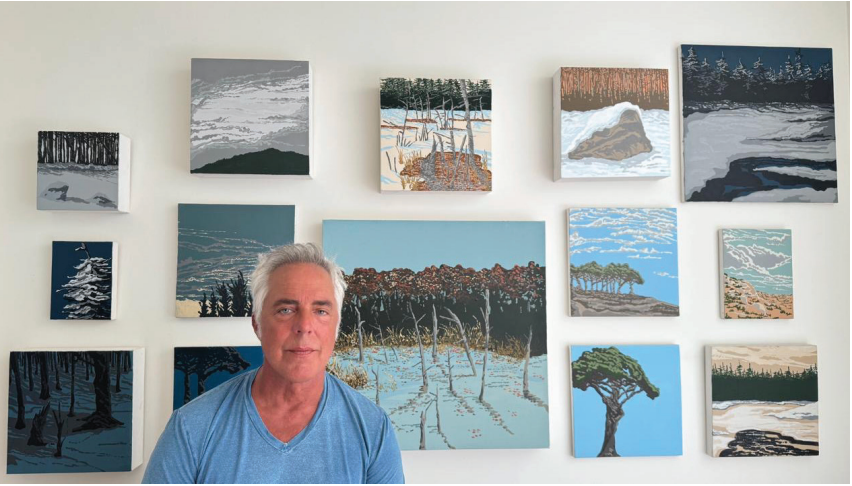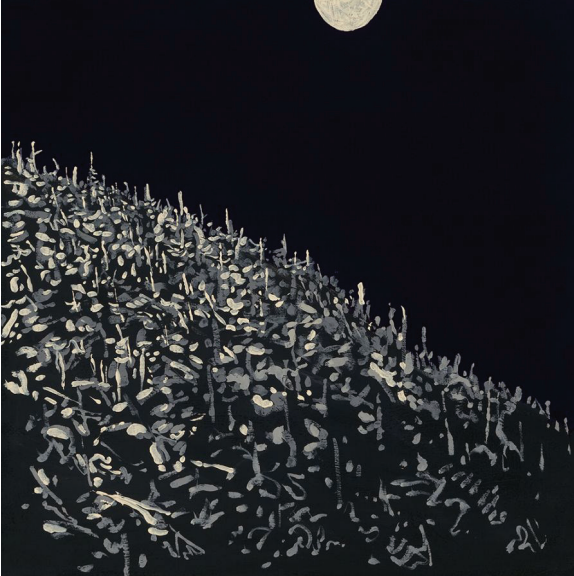Titus Welliver
On Set and in the Studio

While most know Titus Welliver as the passionate detective in the television series Bosch and Bosch Legacy, what they may not be aware of is that the actor is also an accomplished painter whose has works hanging in The Metropolitan Museum of Art. If you believe in genetics, the actor, named after Rembrandt’s son, could not have been better planned in a lab for the life of an artist. His Mother, Norma Cripps, was a fashion illustrator, and his father, Neil Welliver, was a highly regarded landscape painter who taught at Yale and then chaired The University of Pennsylvania’s Fine Art program. “I spent a lot of my free time conversing about art and sitting in their studios as a kid,” explains Welliver with animation. “Both my parents had huge rolls of butcher’s paper and always big boxes of crayons, markers, and latex paint, and we would sit for hours drawing and painting.” At about age 12, it was clear he would follow in his familial footsteps and began serious formal training with his father as a painter. “To say that was grueling as a kid,” says Welliver in his baritone voice, taking a pause for emphasis before finishing the thought, “that would be an understatement.” A brilliant teacher who did not hold back at all, Welliver says the lessons he learned from his father had aided him far beyond painting, especially navigating 40-plus years of career as an actor in the New York theatre and Hollywood where taking criticism is a job requirement. “Direction was not emotional. It was instructional and was able to take it on board and not have it defeat or discourage me.” While Welliver was trained by his father to paint in oils, his medium of choice is acrylics. It is his unique artistic process that led to this shift. Welliver does not use photographs for reference nor works en plein air style. Instead, he visits a powerful place in nature and paints directly from his head in a manner one might parallel to “sense memory” acting, a style made famous by one of Welliver’s former theatre teachers, Lee Strasberg. “The thing about painting that way is that it’s in my head, and I have to get the image on the canvas with some alacrity, and I can’t do that with oil paint.” He isolates different colors with a hair dryer so he can continue to work instead of waiting for one area to dry.” It’s somewhat unorthodox but has always worked for me. Painting from a photograph felt very restrictive because ultimately, what I was doing was recreating that photograph and not recreating the experience of being in that place.”
People leap to the conclusion that his painterly inspiration is his father. While he does admire the work of his family’s patriarch and recognizes certain stylistic similarities, one of Welliver’s greatest influences was Tom Thomson, a lesser-known Canadian landscape artist from “The Group of Seven” movement at the turn of the century. He also finds vision in a broad range of artists such as Alex Katz, Wayne Thibault, and Hokusai. He recalls a behemoth tome of Hokusai’s works his mother gifted to him at age ten that became a catalyst to explore his practice. “How do you take something that appears very flat on the surface and yet there is a depth and dimension to that work that’s deeply moving that pulls you into the image.”

When he completes a work, it must give him a visceral feeling of revisiting the place that moved him, or it never makes it out of the studio. Like many before him, such as Francis Bacon, Agnes Martin, and Jasper Johns, Welliver explains the moment as emotional and if the painting doesn’t emote that, he takes out a knife, cuts it up, and throws it in the trash. “As an actor, I also edit my performance inside of the camera, meaning I don’t put forward any work that I don’t feel comfortable for an editor to have access to; if I don’t like a take, I will stop because I don’t want it out there.” Welliver only started painting again a few years ago after a long hiatus when his very busy schedule juggling call times with a young family left little space for additional personal pursuits. He then met his now wife Sam Edge, and was inspired on so many levels. “Talk about having a muse and being inspired by someone you have such profound depth of love for,” he smiles through his words, and you can see his entire body language shift. The first painting he did was a night scene of a full moon over the tops of the trees at his home in Connecticut, aptly titled “Sams Moon.” She has the original painting, and the print is hanging in the Mezzanine at the MET, not far from those of Red Grooms and his father.” It’s wild,” and you can feel he is truly humbled.” I feel a sense of pride and also wonder how the hell I got to be near those guys.” Before his father passed in 2005, Welliver decided to show him some of his recent paintings knowing he could react in a myriad of ways. At first there was no response, but he could see his father looking and scrutinizing.
Finally, he said, “They are beautiful.” When Welliver thanked him, his father replied again; “Go fuck yourself. Why are you thanking me? What does it matter what I think if you know they are beautiful, and you know they are great nothing else matters, “explaining his theory that painting should be done for yourself first and foremost. He finished by telling Welliver he was a little jealous since he could no longer hold a paintbrush. “My Father was extremely proud of the work I did as an actor and extremely supportive. This came from a place of respect, and it was incredibly freeing.” The Bosch series has run for ten years, inspired the -spinoff with another called – where MaggieQ portrays a young homicide detective in the works. Welliver, who is known as an “actors’ actor,” recently fulfilled another lifetime dream, working with Al Pacino in a soon-to-be-released feature film called “Killing Castro”. Welliver portrays Allen Dulles, the head of the CIA, in the true story surrounding Fidel Castro’s visit to the United States, which eventually involved Malcolm X, The CIA, and the Mafia.” I walked in set and Pacino went ‘Harrrrrry Bosch…’ in that signature voice. It was surreal, and he was lovely, and he told me great stories about making films over the years. We are both kind of old school.” Welliver does not take for granted the opportunities the arts afford him as an actor and a painter. “They use two different parts of the brain and, in that way, feel very fortunate. The fact I can use my brain for two artistic pursuits makes me happy doesn’t make me any smarter but…just means I feel luckier.”





